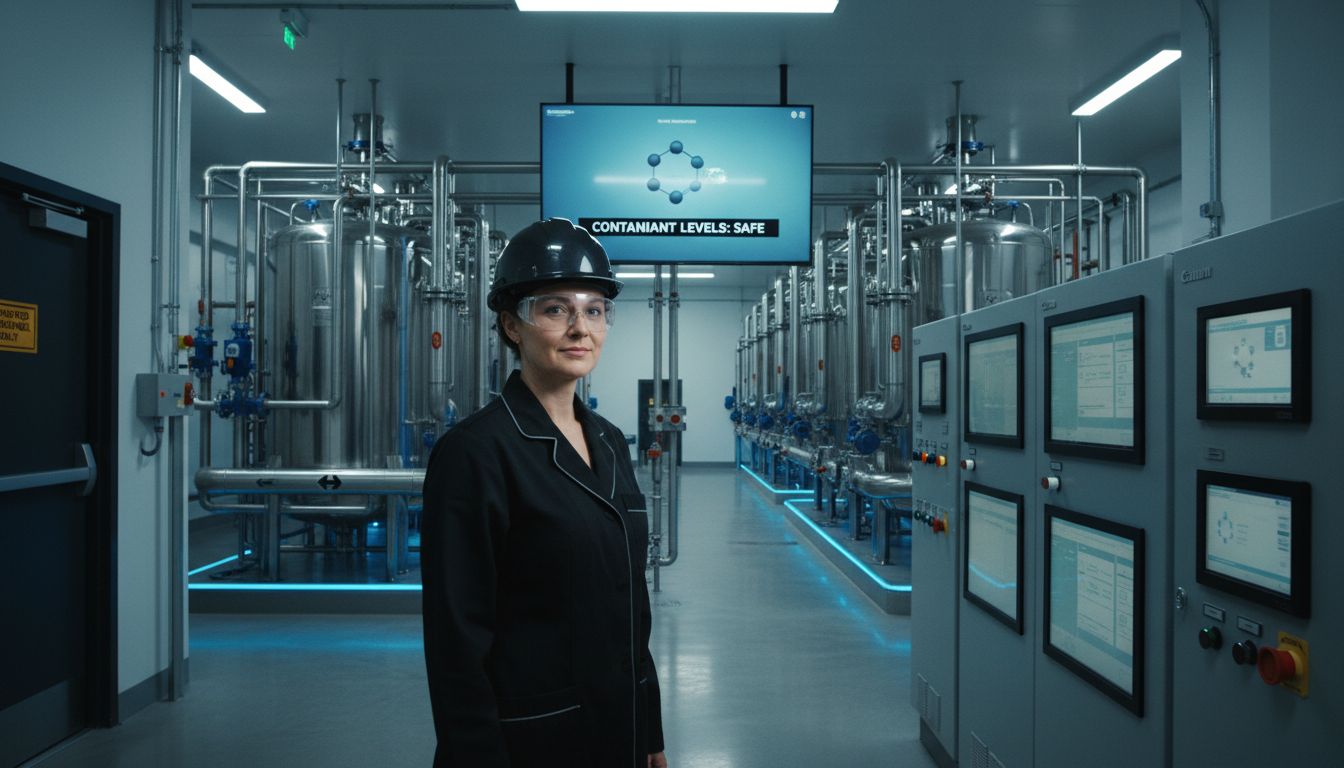Uncategorized
Groundwater Purification: Everything You Need to Know
Did you know nearly 50 percent of people in the United States rely on groundwater for drinking water? Yet, this vital resource can carry invisible dangers from both natural minerals and human-made chemicals. Contaminated groundwater can pose real threats to your health and safety. Understanding how purification works can help you protect your household, reduce health risks, and ensure that every drop you drink is as clean as it looks.
Table of Contents
- What Is Groundwater Purification?
- Common Groundwater Contaminants And Risks
- Popular Groundwater Purification Methods
- Health And Safety Benefits For Users
- Legal Guidelines And Water Quality Standards
- Comparing Purified Vs. Untreated Groundwater
Key Takeaways
| Point | Details |
|---|---|
| Importance of Groundwater Purification | Groundwater purification is essential for removing contaminants, ensuring safe drinking water for communities. |
| Health Risks of Contaminants | Common groundwater pollutants pose significant health risks, including cancer and neurological disorders, necessitating stringent monitoring. |
| Purification Methods | Effective techniques like filtration and chemical treatment are crucial for achieving high water quality and safety standards. |
| Regulatory Framework | Legal guidelines and standards are vital for regulating groundwater quality and protecting public health through comprehensive monitoring. |
What Is Groundwater Purification?
Groundwater purification is a critical process designed to remove harmful contaminants from underground water sources, ensuring safe drinking water for communities. According to the Environmental Protection Agency, groundwater can be contaminated by diverse sources including industrial discharges, agricultural activities, and natural geological processes.
The purification process involves multiple advanced techniques targeting different types of pollutants. Contaminant removal typically addresses both natural elements like arsenic and radon, and human-induced chemicals such as pesticides and industrial waste. Sustainable water purification methods play a crucial role in protecting public health and environmental sustainability.
Key steps in groundwater purification include:
- Comprehensive initial water testing
- Identifying specific contaminant types
- Selecting appropriate filtration technologies
- Implementing multi-stage treatment processes
- Continuous monitoring and quality verification
By systematically addressing potential health risks, groundwater purification transforms potentially dangerous water sources into safe, consumable resources for households and communities.
Common Groundwater Contaminants and Risks
Groundwater faces significant contamination challenges from both natural geological processes and human activities. According to the United States Geological Survey, several hazardous contaminants pose serious health risks to communities relying on groundwater sources.
Inorganic Contaminants represent a primary concern in groundwater safety. Research indicates multiple dangerous substances can infiltrate water supplies, including:
Here’s a structured overview of common groundwater contaminants and their associated health risks:
| Contaminant | Source | Health Risks |
|---|---|---|
| Arsenic | Natural geology | Carcinogenic effects |
| Nitrate | Agricultural runoff | Methemoglobinemia (“blue baby”) |
| Uranium | Natural radioactive deposits | Kidney damage Cancer risk |
| Manganese | Geological & industrial runoff | Neurological disorders |
| PFAS | Industrial/consumer products | Immune system disruption Cancer |
- Arsenic: Known carcinogenic compound
- Nitrate: Often originating from agricultural runoff
- Uranium: Naturally occurring radioactive element
- Manganese: Potential neurological risk factor
Human-induced Per- and Polyfluoroalkyl Substances (PFAS) have emerged as particularly dangerous groundwater pollutants. These synthetic chemicals, commonly found in industrial and consumer products, can lead to significant health complications including developmental problems, immune system disruptions, and potential cancer risks.
Preventing groundwater contamination requires comprehensive monitoring, advanced filtration technologies, and stringent environmental regulations. Water filtration methods play a critical role in identifying and removing these potentially harmful substances before they reach consumer water supplies.
Popular Groundwater Purification Methods
Groundwater purification relies on several sophisticated techniques designed to eliminate harmful contaminants and ensure water safety. According to the Environmental Protection Agency, these methods encompass filtration, chemical treatment, and biological processes that work together to meet critical drinking water standards.
Filtration Technologies play a crucial role in groundwater purification. Water purification methods typically include multiple approaches such as:
- Activated Carbon Filtration: Removes organic compounds and improves water taste
- Reverse Osmosis: Eliminates dissolved solids and microscopic contaminants
- Ion Exchange: Targets specific mineral ions and heavy metals
- Biological Filtration: Uses natural microorganisms to break down pollutants
Chemical treatment methods complement these filtration techniques, involving processes like chlorination, oxidation, and advanced chemical neutralization. These approaches effectively neutralize potentially dangerous microorganisms and transform harmful chemical compounds into safer substances.
The ultimate goal of groundwater purification is comprehensive contamination removal, ensuring that water not only looks and tastes clean but meets stringent health and safety regulations. Continuous technological advancements continue to improve these purification methods, making safe drinking water increasingly accessible.
Health and Safety Benefits for Users
Groundwater purification offers critical health protections by dramatically reducing exposure to dangerous contaminants that can lead to serious medical conditions. According to the United States Geological Survey, proper water treatment significantly decreases the risk of numerous health complications, including cancer, neurological disorders, and developmental problems.
Health Risk Reduction encompasses multiple critical benefits for users:
- Elimination of toxic heavy metals
- Removal of potentially carcinogenic compounds
- Prevention of waterborne disease transmission
- Neutralization of harmful microbiological agents
- Mitigation of long-term genetic and neurological risks
Types of water filters play a crucial role in safeguarding public health by providing multiple layers of protection. The Environmental Protection Agency emphasizes that comprehensive groundwater purification ensures drinking water meets stringent safety standards, protecting vulnerable populations such as children, elderly, and individuals with compromised immune systems.
Beyond immediate health benefits, consistent groundwater purification contributes to long-term community wellness. By systematically removing contaminants, these advanced filtration technologies help prevent chronic health issues, reduce medical treatment costs, and promote overall public health resilience.

Legal Guidelines and Water Quality Standards
Groundwater quality regulation represents a critical framework designed to protect public health and environmental safety. According to the Clean Water Act, comprehensive legal guidelines establish stringent standards for water contamination prevention and management across various jurisdictions.
Regulatory Mechanisms for groundwater protection include multiple strategic approaches:
- Federal monitoring and enforcement protocols
- State-level water quality assessment programs
- Mandatory contamination reporting requirements
- Comprehensive groundwater testing standards
- Strict penalties for environmental violations
Water purification methods must comply with these complex regulatory frameworks. The Wellhead Protection Program specifically mandates comprehensive strategies to safeguard underground drinking water sources from potential contamination, requiring states to develop and implement robust protection plans.
Implementing these legal guidelines demands continuous collaboration between environmental agencies, local governments, and water management professionals. By establishing clear standards and enforcement mechanisms, these regulations ensure that groundwater remains a safe and reliable resource for communities, protecting public health and environmental sustainability.
Comparing Purified vs. Untreated Groundwater
The distinction between purified and untreated groundwater represents a critical health consideration for consumers and communities. According to the United States Geological Survey, untreated groundwater can harbor a complex array of potentially dangerous contaminants from both natural geological processes and human-induced environmental impacts.
Contamination Characteristics highlight the significant differences between purified and untreated water sources:
- Untreated Groundwater:
- Contains natural and synthetic contaminants
- Potential presence of heavy metals
- Risk of microbial and chemical pollutants
- Unpredictable water quality
- Purified Groundwater:
- Systematically removes harmful substances
- Meets rigorous safety standards
- Consistent and reliable quality
- Reduced health risks
Water filtration methods play a transformative role in converting potentially hazardous untreated water into safe, consumable resources. The Environmental Protection Agency emphasizes that purification processes effectively neutralize contaminants, ensuring water meets comprehensive health and safety regulations.
Ultimately, the choice between purified and untreated groundwater represents a fundamental decision about personal and community health. Purification transforms an uncertain water source into a reliable, safe drinking resource, providing peace of mind and critical protection against potential long-term health complications.
Protect Your Home with Advanced Groundwater Purification Solutions
Unsafe groundwater carries risks like harmful heavy metals and chemical contaminants that threaten your family’s health every day. You deserve water purification that targets these dangers precisely and delivers safe, clean water right from your tap. Advanced filtration technologies like activated carbon, reverse osmosis, and UV sanitization make it possible to eliminate contaminants such as arsenic, nitrates, and PFAS with proven effectiveness.
Discover how our selection of premium water purifiers at Coway Water Purifier Uncategorized Archives can meet these essential needs.

Don’t wait for health risks to become emergencies Take control now by exploring our reliable water filtration options at Coway Water Purifier. Experience the confidence that comes with cleaner water and trusted service including free delivery and installation. Visit https://cowayswaterpurifier.com today to choose the perfect system for your home and ensure the safety your loved ones deserve.
Frequently Asked Questions
What is groundwater purification?
Groundwater purification is the process of removing harmful contaminants from underground water sources to ensure safe drinking water for communities.
What are common contaminants found in groundwater?
Common groundwater contaminants include arsenic, nitrate, uranium, manganese, and Per- and Polyfluoroalkyl Substances (PFAS), which pose various health risks.
What methods are used for groundwater purification?
Techniques for groundwater purification include activated carbon filtration, reverse osmosis, ion exchange, biological filtration, and chemical treatments like chlorination and oxidation.
Why is groundwater purification important for public health?
Groundwater purification significantly reduces exposure to harmful contaminants, helping to prevent serious health conditions such as cancer, neurological disorders, and waterborne diseases.
Recommended
- Understanding Water Purification Terms Explained Clearly – Coway Water Purifier
- 7 Top Water Filtration Methods You Need to Know – Coway Water Purifier
- What is Under-Sink Water Purifier? Understanding Its Importance – Coway Water Purifier
- What is Water Purification? Understanding Its Importance – Coway Water Purifier

